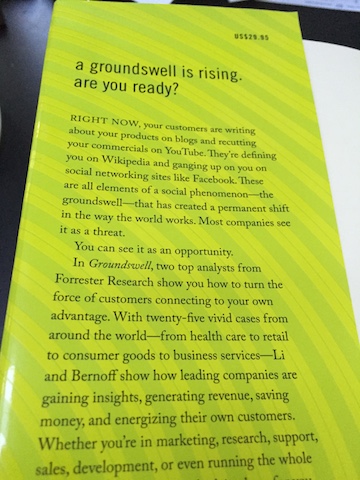Write the marketing pitch first, before you build the product
 Trying to figure out what you’re building? Figure out first how you’re going to sell it. Write that. Then you’ll know what to build.
Trying to figure out what you’re building? Figure out first how you’re going to sell it. Write that. Then you’ll know what to build.
When Charlene Li and I sat down to plan our book, we needed to start somewhere. She had a lot of great ideas about social media, but we didn’t know which of those ideas belonged in the book or how we would organize them. We had an idea for a title, but it wasn’t very good.
So we wrote the flap copy — you know, the copy you read on the inside flap of the book jacket. While we were selling a book that didn’t exist, we wanted to make a promise about what the book would do. So I sat down at a laptop plugged into a projector and we tossed around some words, which we then rearranged until we were happy with them.
One of the words I typed was “groundswell.” We both looked at each other and said “That’s a very interesting word.” And it became the title of the book.
Our flap copy became the promise of what we would do for the reader. It also became our beacon; we strove to make sure the table of contents and eventually, the content of each chapter lived up that promise.
I’ve done this before. The chief engineer and president of one of my former software companies asked me to write draft pages for the manual that explained how to use yet-to-be-developed features. It was a way of working out how things should work. He would then build the features to match, not a spec, but a description of use.
Next time you build something, try this. Don’t write a marketing plan. Don’t write a spec. Write the ad copy. Imagine that the product is done and you’re building a site for it. In 10 words, 50 words, or 200 words, write down the copy that will sell people on the product. Make promises.
Once you’ve done that, write the specs and plans and then build the product to match the promises.
Products change as you build them. You’re going to have to rewrite that copy at the end of the project to match what you actually come up with. But if you at least try to write it at the beginning, you’ll be focusing on the customer and the benefit. That’s a great way to start building something. And if you can’t do that, why are you bothering to build it anyway?
Photo: Josh Bernoff
Great advice, and well-known among consumer product companies, but much less for B2B marketers. At my firm (a well-known CE manufacturer) every product starts with a “product story” that includes a business rationale and a preliminary vision for the ad copy. I believe P&G does something similar.
Forrester push their social bullshit agenda, to make major players pay for their useless research.
However, I like how you cut the bullshit, but your company you work or you used to work for is the bullshit itself.
You’re right on pitching first than building the product after, it’s a good strategy that gives time to you to get the most of what people want and serve it on a hot dish.
My experience at Forrester is that the analysts writing the research were earnestly trying to create the best possible advice for clients, in an unbiased way, based on actual research.
You’re certainly welcome to your opinion regarding whether the research is worth it, but if you don’t want it, don’t buy it. It’s that simple.
I will resist any suggestion that Forrester is biased or has an agenda, because in 20 years of working there, mostly in senior positions, I saw very little of that.
In the early stages of fleshing out your business idea, you can just write down a few bullet points about how you will make money and what your key expenses will be. As you refine your business idea, you will want to turn these initial notes into a sales forecast and an expense budget. Do you need to find a location?